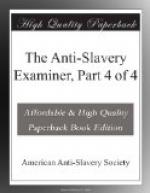These are the clauses which the abolitionist, by voting or taking office, engages to uphold. While he considers slaveholding to be sin, he still rewards the master with additional political power for every additional slave that he can purchase. Thinking slaveholding to be sin, he pledges to the master the aid of the whole army and navy of the nation to reduce his slave again to chains, should he at any time succeed a moment in throwing them off. Thinking slaveholding to be sin, he goes on, year after year, appointing by his vote judges and marshals to aid in hunting up the fugitives, and seeing that they are delivered back to those who claim them! How beautifully consistent are his principles and his promises!
OBJECTIONS.
OBJECTION I.
Allowing that the clause relating to representation and that relating to insurrections are immoral, it is contended that the article which orders the return of fugitive slaves was not meant to apply to slaves, but has been misconstrued and misapplied!
ANSWER. The meaning of the other two clauses, settled as it has been by the unbroken practice and cheerful acquiescence of the Government and people, no one has attempted to deny. This also has the same length of practice, and the same acquiescence, to show that it relates to slaves. No one denies that the Government and Courts have so construed it, and that the great body of the people have freely concurred in and supported this construction. And further, “The Madison Papers” (containing the debates of those who framed the Constitution, at the time it was made) settle beyond all doubt what meaning the framers intended to convey.
Look at the following extracts from those Papers:
Tuesday, August 28th, 1787.
Mr. Butler and Mr. Pinckney moved to require
“fugitive slaves and
servants to be delivered up like criminals.”
Mr. Wilson. This would oblige the
Executive of the State to do it,
at the public expense.
Mr. Sherman saw no more propriety in the
public seizing and
surrendering a slave or servant, than
a horse.
Mr. Butler withdrew his proposition, in
order that some particular
provision might be made, apart from this
article.
Article 15, as amended, was then agreed
to, nem. con.—Madison
papers, pp. 1447-8.




